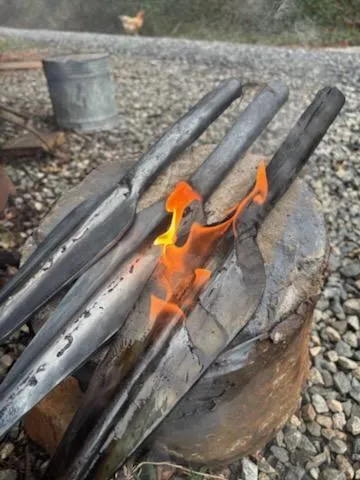
What makes a weapon a VIKING weapon?
More than Steel - It was Identity, Legacy, and War
When most people picture a Viking weapon, they imagine something heavy, oversized, and dripping with drama. Maybe a massive battle-axe or an engraved sword worthy of a fantasy epic. And those images are cool…but real Viking weapons were less about flashy looks and more about function, symbolism, and survival. So what truly defines a Viking weapon? Let’s break it down.
1. The Craft: Pattern-welded steel and functional design
The Vikings weren’t just warriors; they were smiths, engineers, and artists. Viking swords and axes were often pattern-welded, a technique where layers of iron and steel were twisted and folded to create stronger, more flexible blades.
This process didn’t just make the weapon more durable, it made it beautiful. The swirling patterns in the steel weren’t decoration but instead were a mark of serious craftsmanship. If you saw those patterns, you knew that blade meant business.
Any while the ornate blades of high-status warriors existed, most Viking weapons were simple, efficient, and deadly. A sword wasn’t meant to look good on a wall. It was meant to defend your home or win your next raid.
2. Lightweight and Ready for Battle
Real Viking weapons weren’t heavy like video games or movies make them out to be. In fact, a typical Viking sword only weighed about 2 to 3 pounds. Axes were balanced for single-handed use, often paired with a shield in the other hand. These tools were made for speed, not brute force.
That balance made them deadly in close quarters and practical for travel, too. Vikings were seafarers, raiders, and explorers. Their gear had to keep up.
3. They had names and a life of their own
Viking warriors loved using their weapons, but believe it or not, they actually bonded with them. Made blades were named, just like ships or family heirlooms.
Names like:
-”Leg-biter”
-”Skofnung” (believed to be imbued with spirits)
-”Blood-ice”
These names would tell a story. A weapon was a part of a warrior’s identity, not just a tool with flair. Imagine wielding the same sword your grandfather used in battle. That’s how serious this was. Weapons were passed down, buried in graves, and in some cases, believed to be cursed, enchanted, or protected by the gods.
4. Beyond Swords: The Viking Arsenal
While swords were the high-status weapon of choice, not everyone had one. Vikings also used:
-Axes - the most common weapon. Light, deadly, easy to make
-Seax (short blades/daggers) - great for utility and close combat
-Spears - cheap, versatile, and excellent for both throwing and melee
-Bows - essential for hunting and long-range skirmishes
In fact, many Viking warriors would go into battle with just a shield and axe. Simple, brutal, effective.
So what does that mean today?
At our forge, Jeremy teaches blacksmithing but also revives a mindset. When you forge your own blade here, you’re not just shaping steel. You’re building a connection to something ancient. You’re literally making a tool that could last a lifetime. A piece of art that carries your story. And maybe someday, you pass it down.
You choose the weapon you want to make. You strike the steel. You name it (we won’t judge). But one thing’s for sure:
You’ll never look at a store-bought knife the same again.